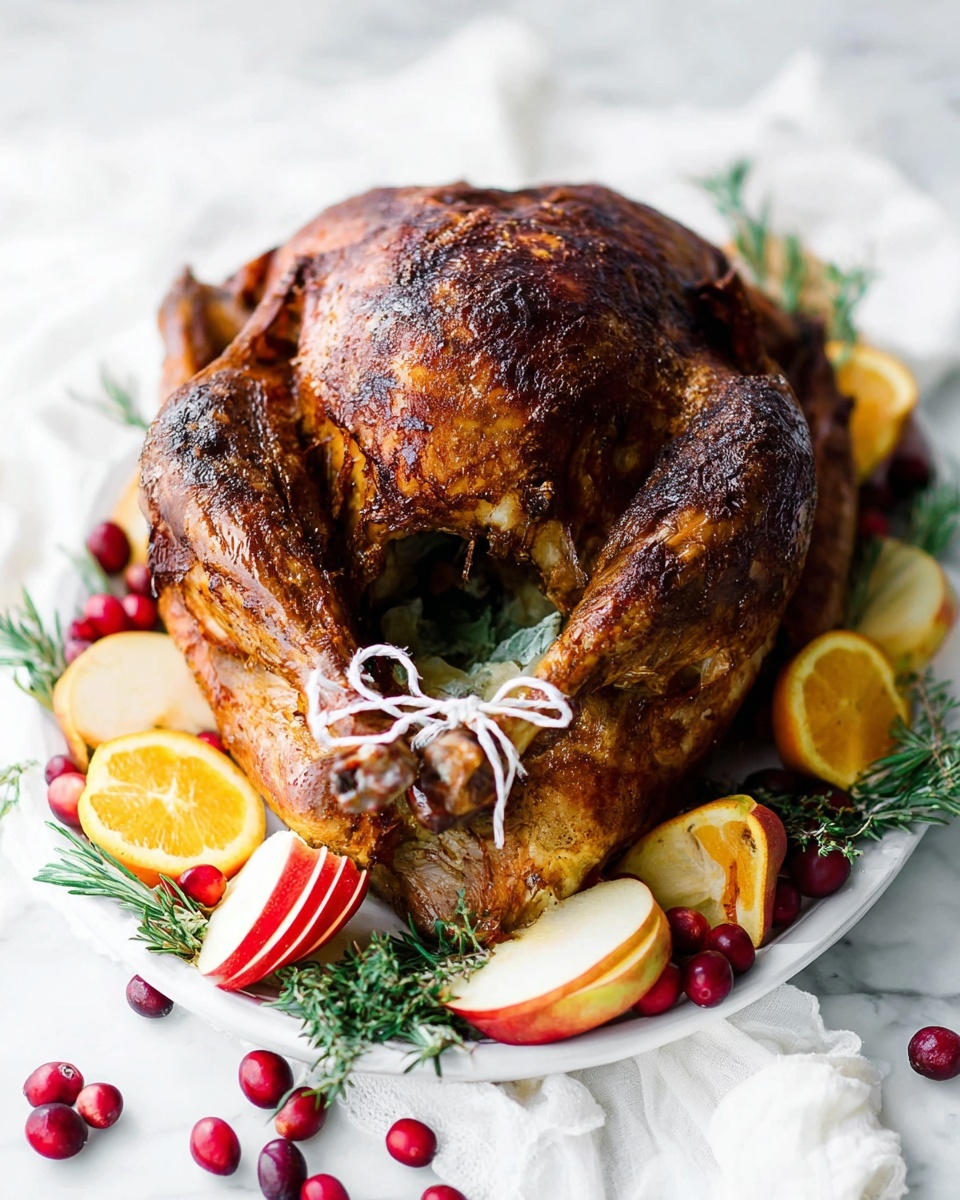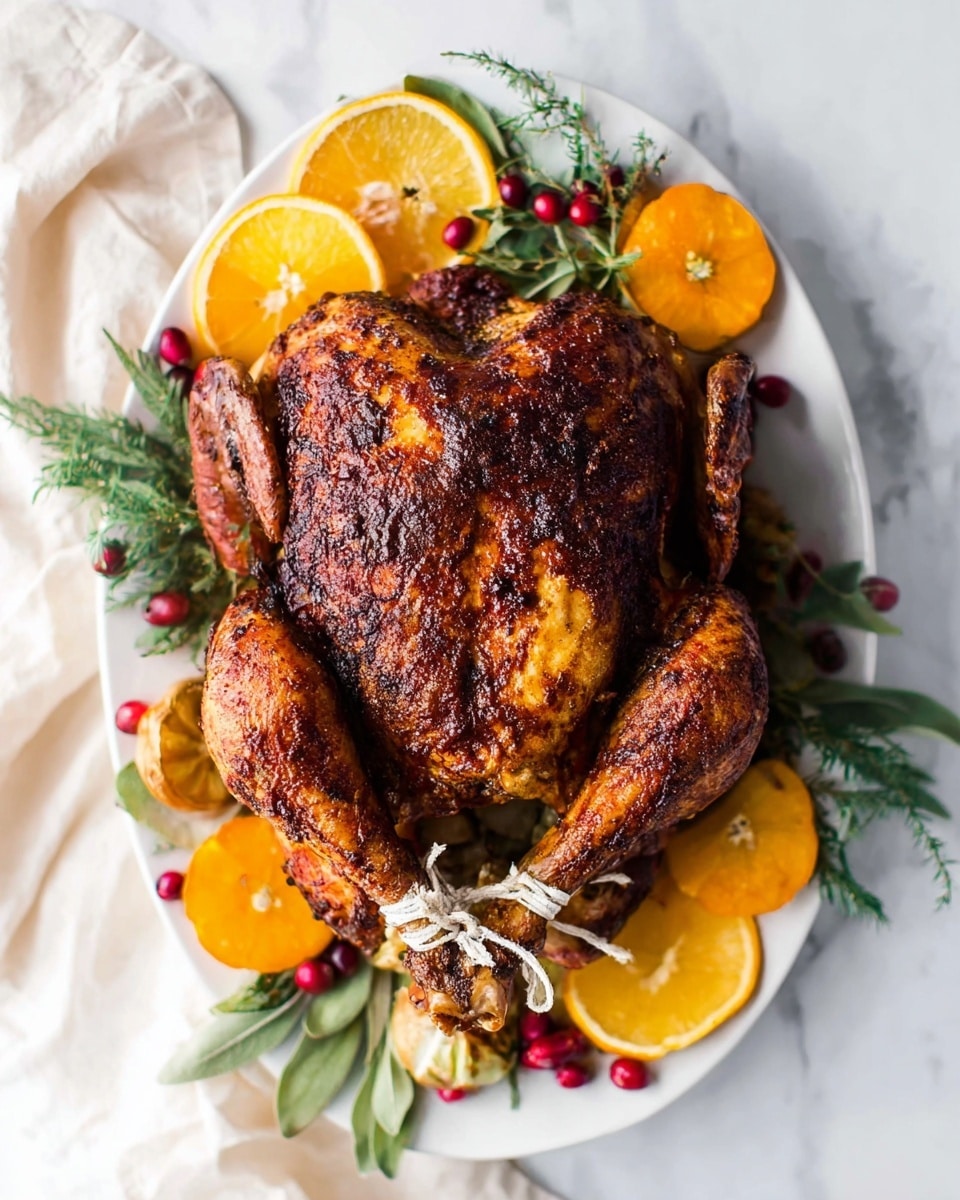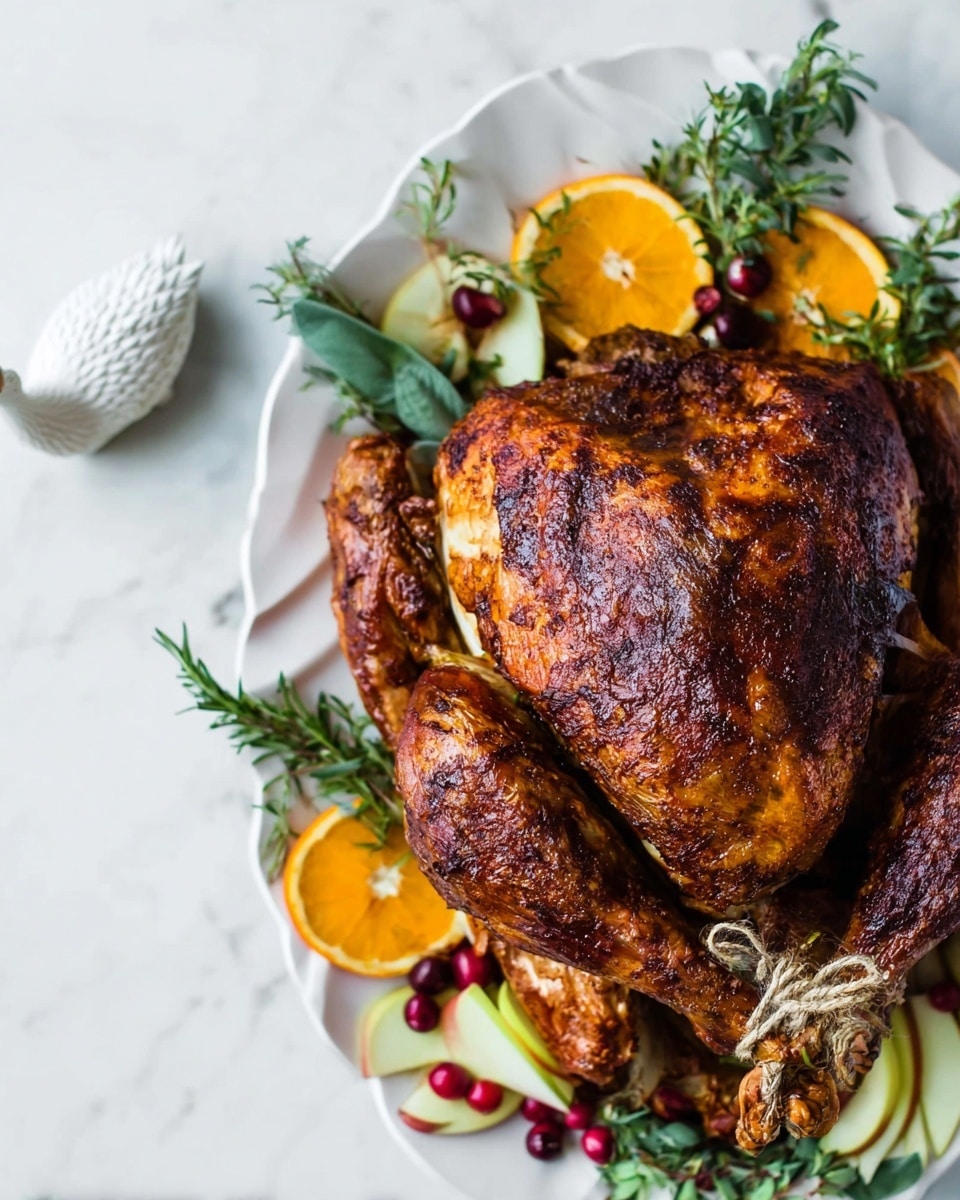If you’re craving a show-stopping centerpiece that’s crispy on the outside and juicy on the inside, you’ve come to the right place. I’m thrilled to share The Best Fried Turkey Recipe with you—this isn’t just any fried turkey, it’s my family’s all-time favorite. When I first tried frying a turkey, I was amazed at how quickly it cooked and how unbelievably flavorful it turned out. Whether it’s Thanksgiving, a backyard gathering, or any festive occasion, you’ll find that this fried turkey recipe brings the wow factor every single time.
Why You’ll Love This Recipe
- Flavor Explosion: The secret injection marinade combined with a perfectly balanced dry rub means every bite is packed with bold, savory goodness.
- Juicy Yet Crispy: Unlike oven-roasted turkey, frying seals in moisture while creating a delectably crispy skin you’ll crave.
- Fast Cooking: It cooks way faster than traditional roasting – which means more time enjoying and less time waiting.
- Showstopper Every Time: This turkey steals the spotlight at family dinners, and trust me, your guests will be asking for the recipe.
Ingredients You’ll Need
Each ingredient in The Best Fried Turkey Recipe works together to create that perfect combo of spice, moisture, and crispy skin. I recommend grabbing fresh, high-quality spices for the best results, and don’t skip the peanut oil—it’s key to that amazing fry.
- Large Turkey (under 18 lbs): I always prefer fresh or fully thawed for even cooking and safer frying.
- Peanut Oil: It has a high smoke point and neutral flavor, perfect for deep frying without any burnt taste.
- Chili Powder: Adds a subtle smoky kick to the rub.
- Paprika: Gives color and a mild peppery flavor, plus that beautiful golden finish.
- Garlic Salt: Brings savory depth everywhere it touches.
- Onion Salt: Enhances sweetness and umami notes in the turkey.
- Seasoning Salt: Balances and boosts the overall flavor profile.
- Fresh Ground Pepper: Needed for a little spicy warmth.
- Melted Butter: Helps keep the bird moist and adds richness.
- Canola or Vegetable Oil: Used in the injection marinade for moisture and flavor distribution.
- Worcestershire Sauce: Adds complexity and a touch of tangy umami.
- Water: Helps balance the injection marinade’s consistency.
- Fresh Lemon Juice: Slight acidity to brighten flavors and tenderize.
- Ground Sage: Classic herb bringing a warm, earthy note.
- Dried Thyme: Adds subtle herby hints throughout the turkey.
Variations
One of the best things about The Best Fried Turkey Recipe is how easy it is to tweak for your flavor preferences or dietary needs. I often play around with the herbs or add a little heat for some extra kick.
- Spicy Variation: I love adding cayenne pepper or chipotle powder to the dry rub when I want a smoky, tingly heat that wakes up the palate.
- Herb-Heavy: Sometimes I amp up the fresh herbs like rosemary and thyme in the injection for an earthier, fragrant turkey.
- Gluten-Free Adaptation: This recipe is naturally gluten-free, but always double-check Worcestershire sauce brands to ensure they meet your needs.
- Lemon and Garlic Boost: Fresh lemon zest and extra garlic minced in the rub turn the flavor bright and savory—perfect for springtime feasts.
How to Make The Best Fried Turkey Recipe
Step 1: Getting That Turkey Ready with Marinade Magic
The first thing I do is thaw my turkey completely—no shortcuts here because a frozen or partially frozen bird can be dangerous when frying. Once thawed, give it a good rinse, then pat it dry thoroughly inside and out. Next, combine the injection marinade ingredients: melted butter, oil, Worcestershire sauce, water, lemon juice, sage, thyme, garlic salt, and onion salt. Using a flavor injector, poke just one hole into the breast and rotate the needle as you slowly squirt the marinade; this infuses the turkey with moisture and flavor in every bite without making a mess or losing juices. I usually do this in just a few key spots, minimizing holes to keep the bird juicy.
Step 2: Rubbing It Down with Love
Mix all the rub spices together—chili powder, paprika, garlic salt, onion salt, seasoning salt, and fresh ground pepper—and massage it all over the outside of the turkey. Don’t forget to get some rub inside the cavity and under the skin for deep layers of aroma and taste. After that, wrap the bird tightly in plastic wrap and refrigerate it for at least an hour, though I recommend up to 24 hours if you can wait—the flavors deepen and the turkey becomes even more tender.
Step 3: Preparing to Fry Safely and Smart
When you’re ready to fry, start by filling your frying pot with water up to the first fill line. Place the turkey inside a big airtight bag and submerge it to test how much oil you’ll need—mark the water line so you don’t overfill your pot with oil. Safety first: you want the turkey fully covered by the peanut oil but avoid spillover when the bird’s added. Then, drain the water, dry the pot, and pour in peanut oil up to the marked level. Heat the oil to 275°F before adding the turkey.
Step 4: Frying Perfection
Remove the turkey from plastic wrap and pat it dry again. Use a sturdy hook or hanger to slowly lower the turkey into the hot oil, wearing gloves to protect your hands from any splashes. Insert your deep-fry thermometer probe into the thickest part of the breast, and once the oil hits 325°F, cover the pot to keep the temperature steady. Fry it until the turkey’s internal temperature reaches 165°F—that usually takes about 3 to 4 minutes per pound. Trust your thermometer here; it’s the best way to prevent over- or under-cooking.
Step 5: Resting and Carving
Once cooked, carefully lift the turkey from the oil and set it on a wire rack or platter. Let it rest for 20-30 minutes before carving. This resting time locks in juices, so when you slice into it, each piece is tender and bursting with flavor. I usually start with the legs and thighs, saving the breast for last because it stays so moist you’ll want to savor every bite.
Pro Tips for Making The Best Fried Turkey Recipe
- Thorough Thawing: I learned the hard way that partially frozen turkey leads to dangerous oil splatters—make sure yours is completely thawed.
- Temperature Control: Keeping the oil steady between 275°F and 325°F ensures even cooking without burning the skin.
- Minimal Poking: Use as few injection holes as possible to retain natural juices while spreading flavor effectively.
- Safety Gear: Always wear heat-resistant gloves and long sleeves to protect yourself from any hot oil mishaps.
How to Serve The Best Fried Turkey Recipe

Garnishes
I love to garnish my fried turkey with freshly chopped parsley and a few lemon wedges. The green freshens up the plate beautifully, and squeezing a little extra lemon juice over the meat brightens those rich flavors. Sometimes, I add a sprinkle of smoked paprika on top for a little extra color and aroma right before serving.
Side Dishes
My family goes crazy pairing this fried turkey with classic sides like creamy mashed potatoes, buttery green beans, and a fresh cranberry sauce. But if you want to mix it up, roasted sweet potatoes or a tangy coleslaw bring a nice contrast in textures and flavors.
Creative Ways to Present
For special occasions, I like to carve the turkey on a large wooden board surrounded by seasonal fruits like figs, pomegranate seeds, or sliced apples. It’s not just gorgeous—it also invites everyone to dig in family-style. Another fun idea is serving slices piled on flaky biscuits for a festive turkey sandwich experience.
Make Ahead and Storage
Storing Leftovers
After enjoying your turkey, wrap any leftovers tightly in foil or store in airtight containers in the fridge. I find the flavors actually deepen overnight, making for fantastic sandwiches the next day. Just make sure to cool leftovers quickly and refrigerate within two hours of cooking to keep everything safe and fresh.
Freezing
If you want to save some for later, freeze sliced turkey portions in freezer bags or containers. Label and date them — they stay great for up to 3 months. When I thaw mine, I always do it overnight in the fridge to keep texture and moisture intact.
Reheating
To reheat your turkey without drying it out, I recommend popping it into a 325°F oven covered loosely with foil for about 15-20 minutes. This keeps it juicy and warms evenly. You can also refresh the skin a little by uncovering it towards the end for that crispy crunch we all love.
FAQs
-
Can I fry a turkey that weighs more than 18 pounds?
It’s recommended to keep your turkey under 18 pounds for safety and even cooking. Larger birds take longer to fry and increase the risk of oil overflow or undercooking. If you have a bigger turkey, consider frying it in parts or opt for roasting instead.
-
What type of oil is best for frying turkey?
Peanut oil is ideal because of its high smoke point and neutral flavor. It withstands the high frying temperatures needed without burning or imparting unwanted flavors. If you have peanut allergies, canola or vegetable oil are acceptable alternatives but have slightly lower smoke points.
-
How do I ensure my fried turkey is fully cooked?
Using a reliable meat thermometer is key. Insert it into the thickest part of the breast and cook until it reaches 165°F. Also monitor the oil temperature between 275°F and 325°F to ensure consistent cooking. These steps help avoid raw or dry turkey.
-
Is it safe to inject the turkey with marinade?
Yes, injecting the turkey is safe as long as you use clean tools and refrigerate the bird promptly after injection. This method infuses flavor and moisture deep into the meat, making your fried turkey extra juicy and delicious.
Final Thoughts
I absolutely love how this fried turkey turns out every single time—it’s crispy, juicy, and flavorful beyond belief. When I first tried this recipe, I was hooked, and now it’s a staple in my holiday and special occasion cooking. If you want to impress your friends and family with minimal fuss but maximum wow, give The Best Fried Turkey Recipe a try. Trust me, once you taste it, you’ll wonder how you ever made turkey any other way!
Print
The Best Fried Turkey Recipe
- Prep Time: 60 min
- Cook Time: 90 min
- Total Time: 150 min
- Yield: 22 servings 1x
- Category: Main Course
- Method: Frying
- Cuisine: American
Description
This ultimate fried turkey recipe delivers a crispy, flavorful bird with a juicy interior thanks to an injection marinade and a seasoned dry rub. Using peanut oil for frying ensures even cooking and a perfect golden crust. Ideal for holidays or special occasions, the turkey is infused with a blend of spices and fresh lemon for a mouthwatering result that beats traditional roasting.
Ingredients
Turkey and Oil
- 1 large turkey (under 18 lbs)
- 3 gallons peanut oil
Injection Marinade
- 1/4 cup melted butter
- 1/4 cup oil (canola or vegetable)
- 3 tbsp Worcestershire sauce
- 1/4 cup water
- 1/2 large lemon (fresh, squeezed)
Dry Rub Seasoning
- 1 tbsp chili powder
- 1 tbsp paprika
- 1 tbsp garlic salt
- 1 tbsp onion salt
- 1 tbsp seasoning salt
- 1 teaspoon fresh ground pepper
- 1 teaspoon ground sage
- 1 teaspoon dried thyme
- 1 teaspoon garlic salt
- 1 teaspoon onion salt
Instructions
- Prepare the Turkey: Thaw your turkey completely, then rinse and pat dry thoroughly to remove excess moisture which helps achieve a crispy crust during frying.
- Make and Inject Marinade: Mix the injection marinade ingredients (melted butter, oil, Worcestershire sauce, water, and lemon juice) together. Using a marinade syringe, poke one hole and slowly inject the marinade in various parts of the turkey, repositioning the needle to cover as much area inside the meat as possible while using a minimal number of holes.
- Apply Dry Rub: Combine the rub spices including chili powder, paprika, garlic salt, onion salt, seasoning salt, fresh ground pepper, sage, thyme, garlic salt, and onion salt. Rub this mixture all over the turkey’s exterior, inside the cavity, and under the skin to deeply flavor the bird.
- Refrigerate: Wrap the turkey tightly in cling wrap and refrigerate for 1 to 24 hours to allow the flavors to penetrate. The longer it marinates, the better the flavor.
- Prepare Oil and Pot: When ready to fry, fill your frying pot with water up to a first fill line, and place the turkey inside a large airtight bag, then submerge it in the water. Mark the water level so you know how much oil to add to avoid overflow when frying. Dry the pot completely before adding peanut oil to the marked level.
- Heat Oil and Dry Turkey: Preheat the peanut oil to 275°F. Remove the turkey from the refrigerator and unwrap, pat dry once more to eliminate any surface moisture to prevent dangerous oil splatter.
- Fry the Turkey: Carefully lower the turkey into the hot oil using a hanger or hook while wearing protective gloves and arm coverings. Insert a thermometer probe in the turkey, close the lid, and allow the oil temperature to reach 325°F. Fry until the internal temperature of the turkey reaches 165°F for safe consumption.
- Rest and Serve: Remove the turkey from the oil and let it rest for 20-30 minutes to allow juices to redistribute before carving and serving.
Notes
- Life-altering, literally THE BEST fried turkey recipe you will ever eat.
- Use step-by-step instructions and both dry rub and injection marinade for maximum flavor.
- Ensure turkey is completely thawed and dried to avoid dangerous oil splattering.
- Use peanut oil for its high smoke point and neutral flavor.
- Monitor oil temperature carefully to prevent burning and ensure thorough cooking.
- Resting the turkey before carving results in juicier meat.
Nutrition
- Serving Size: 1 serving (about 4 oz cooked turkey)
- Calories: 211 kcal
- Sugar: 1 g
- Sodium: 450 mg
- Fat: 11 g
- Saturated Fat: 3 g
- Unsaturated Fat: 7 g
- Trans Fat: 0 g
- Carbohydrates: 1 g
- Fiber: 1 g
- Protein: 25 g
- Cholesterol: 90 mg



